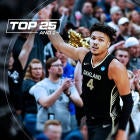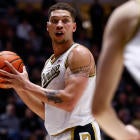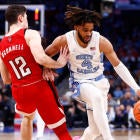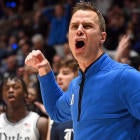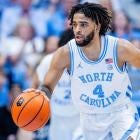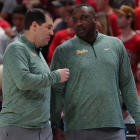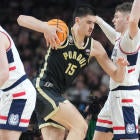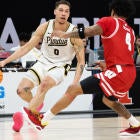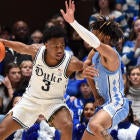
What college basketball conference will be the first to abandon its traditional travel schedule in order to play games in controlled environments?
It's a question dangling above conference commissioners' heads. Nothing is imminent, but at the power-conference level plenty of backup plans are starting to take shape. The WCC explored setting up a Las Vegas-based backup plan in early November but ultimately pushed back on that idea (for now). Out in Vegas, organizers are prepared for any and all West Coast-based leagues to adopt pod play in controlled environments if circumstances dictate.
With conference slates already jumbled in leagues like the Pac-12, ACC and Big East, where postponements have expectedly popped up, commissioners need to be open-minded and limber to do what's healthy, safe and most prudent to keep scheduling integrity intact.
Eye on College Basketball is the world's No. 1 college hoops podcast and publishes three times per week. Check out the latest episode below.
There is reason for optimism with the controlled-environment model. Forget the NBA and its true bubble; college sports can't afford or facilitate such an Atlantis, if you will. But there are methods that have worked in limited sample sizes. Mohegan Sun's "Bubbleville" and bdG Sports' "Beach Bubble" and "Vegas Bubble" were able to stage a combined 49 out of 50 scheduled (or rescheduled) games, with nearly 5,000 tests between the three events that led to zero confirmed cases of COVID-19 contracted in the confines of those events. Bubbleville did have one positive test apiece attached to a few teams that participated in its event (NC State, UConn and Towson) but team officials, citing conversations with epidemiologists and doctors, have said subsequent analysis and contact tracing indicated a much higher likelihood that those teams had positives as a result of activity outside the basketball event and prior to arriving at Mohegan Sun. (Incubation periods remain devilish in this regard.)
"All totaled, 1,742 tests were conducted and the 23 games that were scheduled to be played, were played," bdG Sports said in its statement. "For the venue tracing, the #BeachBubble in Fort Myers featured 14 total check-in device locations, 553 total enrolled users and nearly 4,000 check-ins."
This is what stakeholders needed to see before even entertaining the thought of going to a single site to play conference games. The relative successes of Mohegan Sun, Vegas and Fort Myers might set up some big-league regular-season competition to go to pod-like play in controlled environments in January or February. One league that is preparing to pivot if necessary is the Big East. Commissioner Val Ackerman spoke to CBS Sports on Monday, shortly after the league finally revealed its January-through-March schedule of regular-season games. The plan is still for a traditional travel model.
"We're working regularly with our doctors who continue to maintain that the travel is workable, our campuses have cleared out," Ackerman said. "We think we have the ability to create controlled environments on our campuses for games."
But within hours of the Big East's release, DePaul announced for the third time in a month that it would be going on pause due to coronavirus cases in its program. Not accounting for Ivy League schools, plus Maryland-Eastern Shore and Bethune-Cookman, all of which have opted out of playing this season, DePaul is one of nearly 20 D-I men's programs yet to play a game this season.
"The next two to four weeks are going to be important for us in terms of determining whether this model is feasible or whether we have to shift to pivot to something else," Ackerman said.
If a shift happens, sources previously told CBS Sports that Mohegan Sun, Indianapolis and Washington, D.C. were three sites the Big East homed in on for pod play, if necessary. Ackerman clarified that Chicago is the fourth site in discussion. If this happens -- and it is still a very big if -- the likely scenario would be that the Midwest Big East schools (Creighton, Marquette, Butler, Xavier, DePaul) would be in Chicago or Indianapolis, while the East Coast-based programs (Connecticut, Georgetown, Providence, Seton Hall, St. John's, Villanova) would be at Mohegan Sun or D.C. There's also an option wherein the men's teams could go to one site and the women's teams another.
"Based on the number of days that our schools would want to be on a long road trip, it would be probably easier to set it up as eastern seaboard schools in one place and then the Midwest group in another," Ackerman said.
Should the league go this route, the period of time teams would be in one location would likely range from five to 12 days, depending on when the games needed to be played and what teams needed to fill however many games on their schedule. It would not be an elongated stay, Ackerman said, which is a philosophy echoed by many of her league-commissioner contemporaries. There is the potential for all teams to travel to one spot if circumstances were bad enough in late February that it made more sense to get everyone in one location in order to finish out as much of the schedule as possible.
So what are the conditions that could change things?
"A tightening of state restrictions that could affect travel, one, and two, the ability to conduct a sports event would be would certainly be a factor," Ackerman said. "The state of our programs if they're in rolling quarantines -- that would certainly inform a decision. And where we are nationally. Obviously we're in a difficult place now, but if that were to to deteriorate in a significant way even further that caused many conferences to reassess their plans, that would be a factor."
For example, if a league found itself in a spot where half its teams were in a pause at the same time -- effectively prompting a hiatus -- that could catalyze significant action. Xavier and DePaul are the two (out of 11) men's Big East programs currently halted. Since Nov. 25 Butler, Creighton, Connecticut, Georgetown, Seton Hall and Xavier have all missed games in men's and/or women's hoops. On the men's side, the league hopes to play 15 (out of a possible 110) of its league games before Christmas. Ackerman said the next eight days are big.
These kinds of moves by the Big East or other conferences could also serve as a quasi dress rehearsal for the NCAA Tournament as well. Multiple coaches have expressed privately that going to controlled environments would be ideal to not only prepare for the tournament, but also potentially provide some relief and assurance to players and fans that games could be much more reliably scheduled and played vs. the current model.
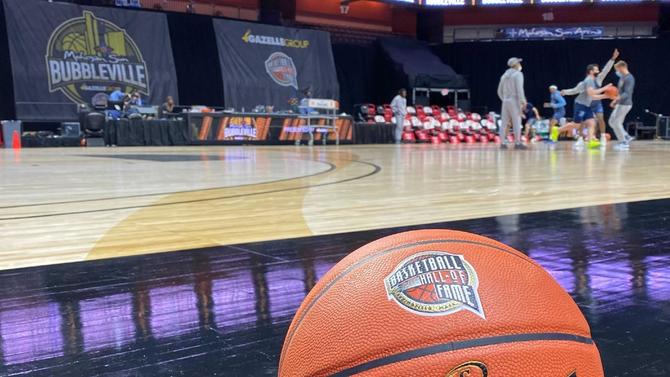
Luka and Cade better than advertised
We are 20 days into the season and the preseason picks for best player (Iowa's Luka Garza) and best freshman (Oklahoma State's Cade Cunningham) have been on the money so far. Let's start with Garza. He is averaging 29.2 points, 9.0 rebounds and 2.2 blocks for a 6-0 Hawkeyes team holding firm at No. 3 in the polls. Garza's shooting 69% from 2-point range and 68% from 3-point range (off a respectable 19 attempts). Most dominant player in college basketball at the moment, bar none. The only two players since 1995-96 to make at least 60% of their shots from 2- and 3-point range in their first five games: Garza and Creighton's Doug McDermott. Also, according to ESPN, Garza joins Duke's Carlos Boozer and NC State's J.J. Hickson as the only players in the past 25 seasons to score 30 or more points and shoot at least 90% in multiple games.
Garza's needed only five to do it, though! His huge stage comes Saturday, when No. 3 Iowa plays top-ranked Gonzaga at noon ET on CBS.
As for Cunningham, he's the leader out of the gate in our first Frosh Watch. Averaging 18.8 points, 5.7 rpg, 3.8 apg, 1.3 bpg and 1.3 spg, the potential No. 1 pick in next year's NBA Draft is paying immediate dividends for the Cowboys. He hit the winning shot in the closing seconds at Wichita State over the weekend, lifting Oklahoma State to 6-0. The Pokes aren't yet ranked but it's their second straight 6-0 start under coach Mike Boynton.
"Has an incredibly high basketball IQ," Boynton told me. "His size allows him to see plays before they happen and he knows when to take over and when to defer."
Colorado player surprised by teammates after PS5 catfish
Colorado freshman Jabari Walker learned a harsh lesson and got a personal redemption story recently. Like millions of other teenagers and college kids, Walker wanted a newly released PlayStation 5. After a couple teammates successfully purchased one via the OfferUp app, Walker decided to go that route too. He found a seller quickly.
"First I had him send me a video of the PlayStation before I went to go get it and it looked new, like it wasn't opened," Walker told me Monday night after Colorado's 81-45 win over Northern Colorado. "He had me trusting him from the jump just on the video. He got the right angles to make it look brand new. I thought everything was good."
Walker doesn't own a car, so he hitched a ride with CU senior Jeriah Horne and fellow freshman Nique Clifford from Boulder, Colorado, to a Walmart parking lot in Aurora shortly after Thanksgiving. It was nighttime. Walker met the seller in person and sent $750 over Zelle.
"He was holding the Play Station box in his hand, you couldn't see the tears or whatever," Walker said. "When the transaction went through, he handed it to me. I immediately thought it was a little light but I hadn't carried a PS5."
After the swap the guy coolly walked away. Walker went back to the car to open the box. He noticed slight inconsistencies with the packaging. Walker opened it hurriedly -- only to find towels, a pair of jeans and an old controller to a PlayStation 3. Confused, duped, angry, he chucked it all out the window.
Walker reported the incident to the police and followed up with the seller to try and get his money back. The man claimed he didn't know the PS5 wasn't in there, that his friend was a businessperson who sold these items on the internet. Soon enough, Walker said the guy's phone number stopped working. He never got his money back. The wide-eyed freshman didn't tell his teammates, but the two in the car who went with him knew.
"The scam happened to me but I wasn't as thirsty to find it as a lot of people were," Walker said.
Eventually the rest of the team found out and they became curious, if not angry, for their brother.
So on Sunday, a pretty cool thing came to be. Colorado had practice in the morning, then broke for the day. Walker went home, got a nap in, and then an usual request: the team's group text had a note from one of the coaches that everyone was to be back at the facility for light practice Sunday night to prep for Monday's game. Walker was listening to his music and mentally prepping for practice. Then he can't find his shoes at his locker. He looks in the drawer underneath.
"It's a box, I'm thinking maybe it's new shoes," he said.
Then Walker sees a couple teammates taking out their phones. Oh, great. A prank on the freshman. Here we go.
Anything but: inside the box is a brand new PS5. His teammates -- spearheaded by Horne -- all pitched in days before, secured the gift, and it produced this scene:
After @jabari521 got scammed trying to purchase a PS5, his teammates stepped in to recoup his loss 🤝
— Colorado Men's Basketball (@CUBuffsMBB) December 14, 2020
This family is special. pic.twitter.com/TpxfS72U7T
"It really is a brotherhood," Walker said, thanking his teammates for their kindness. He really only wanted the PS5 for one thing: marathon sessions of NBA2K with his buddies. The dorm-room battles are already underway.
Stanford assistant crisscrosses country to be there for firstborn
Life has been upside down for everyone in college athletics in 2020, but the past two weeks may have been both more nerve-wracking -- and exciting -- for Stanford assistant Adam Cohen than all others. On Nov. 28 Cohen boarded the team's charter flight destined for the Maui Invitational in Asheville, North Carolina. When the plane left California, Santa Clara County had no ban on close-contact sports competition. By the time Stanford landed, it did.
The complication: Cohen's wife Danielle was less than two weeks out from a scheduled cesarean section for their first child. Cohen revealed he flew back home and quarantined, abiding by county mandates, but missing three of Stanford's games in North Carolina.
"This was the only way I could be in the hospital for the birth," he said. "Having to watch our game vs. UNC and Indiana in a hotel room was far from what I planned. Yelling at the TV was not fun. Being on Zoom team meetings and film sessions while quarantining was not fun."
As he waited for the big day, Cohen tried to do film work from afar. Stanford wound up staying in North Carolina an extra few days because it had no games elsewhere. (It ultimately played NC A&T.) Even the hotel wifi was spotty. At 10:01 a.m. on Dec. 8, Leo James Cohen was born at Stanford Hospital.

Unfortunately, Cohen got all of three days to be a new dad with his family. On Friday night he left his home near Stanford and drove 357 miles to get to Los Angeles so he could be with the team in time to test for COVID-19 and be cleared to be on the bench for Stanford's game on Sunday at USC.
And then that game got postponed due to COVID-19 issues in USC's program; Cohen would have been better off in the short-term staying at home. Now he's living out of a hotel indefinitely. Since Stanford can't play home games due to the ordinance, the Cardinal remain in scheduling hell. They play at Cal State Northridge on Tuesday and then Arizona on Saturday at the Warriors' G League facility in Santa Cruz. When will he get to see his child again?
"Honest to God, I don't know the answer to that yet," Cohen said. "But this isn't just about me. Coach (Jerod) Haase has three children, all the guys on our staff have children. They've been away from their families longer than I have."
Even with quarantine guidelines, ideally the family reunions can happen soon: Stanford has a 12-day scheduled break between games from Dec. 19-31. Stanford's situation, along with Santa Clara and San Jose State, is extremely complicated at the moment. Throw in your firstborn child, and it's all the more stressful and heart-tugging.
@ me
The Court Report always features correspondence from readers/Twitter followers. Please send your questions, curiosities or complaints to me on Twitter.
Even crazier question to ponder- have UNC, Duke, Kentucky, UCLA all been outside the top 20 ever? Trivia time @MattNorlander
— Ben Cary (@zagfan8741) December 14, 2020
Love my followers for curiosities like this. Get ready: The last time UNC, Duke, Kentucky and UCLA were all unranked in the AP poll was December 19, 1961. Caveat: The AP poll was ranking 10 teams per week then. As for your specific question, it's been a top 25 ranking since the 1989-90 season, and every week since then UNTIL this one has seen at least one of UNC, Duke, Kentucky or UCLA ranked inside the top 20. So outside the top 20 for all four, you're talking maybe in the 1980s, otherwise the 1960s is your answer.
Hi @MattNorlander and @GaryParrishCBS, how does this year’s Kentucky compare to last year’s UNC right now?
— Ted (@Envulsion) December 14, 2020
Good question. They're in very different spots. UNC was devoid of talent and overly reliant on one one-and-done star, Cole Anthony. UNC also started 5-0, so it wasn't immediately obviously. Kentucky is much younger this season than UNC was last season. UK doesn't even have a Cole Anthony on the roster. The similarities aren't blatantly obvious to this point, though they are undeniable when it comes to 3-point accuracy, or lack thereof. UNC shot 30.4% from 3-point range and UK is even worse through five games (24.7%).
Final shots
- Shouts to Eastern Illinois' Mack Smith, who has made a 3-pointer in 88 straight games, tying the NCAA D-I record with former Illinois guard Cory Bradford. Smith can set the mark Monday at SIU-Edwardsville.
- The WAC is aggressively looking at expansion. Matt Brown of Extra Points was the first to report last week that the league is homing in on adding Abilene Christian, Lamar, Sam Houston State, Stephen F. Austin and Southern Utah. Sources indicated to CBS Sports the same intel, but one source said not all five schools will have all sports competing in the WAC. What's surprising about this is all of those teams with the exception of Southern Utah are currently Southland Conference members.
- It's early but it appears we missed on a player in our Top 101: Pitt's Justin Champagnie. The sophomore forward is coming off consecutive 20-point, 20-rebound games, joining Purdue's Caleb Swanigan and Oklahoma's Blake Griffin (also coached by Jeff Capel) as players from power conferences to do the same the past 25 seasons.
- An NCAA source told me this week that the NET rankings are scheduled to debut on Jan. 4. The NET's formula could still see tweaks depending on whether or not home court advantage is appreciably altered this season with little-to-no fans in the stands.
- Northwestern AD Jim Phillips is leaving the school to become the next ACC commissioner. This presents a problem for the men's selection committee, as Phillips is in line to be the committee chair for 2021-22, but the rules state each conference can only have one rep. The ACC is already currently represented by UNC athletic director Bubba Cunningham. Expect resolution on this by early January.
- The Big Ten has the best win percentage of any league, .795. Its 62-16 and has six teams without a loss. One of those teams is Rutgers, which is 5-0 with five double-digit wins for the first time since 1934-35.
- Wild: Florida State has won 10 straight overtime games. The record is 11, per NCAA stat ace David Worlock, and it's been done three times: Louisville (1968-75), UMass (1991-96) and Virginia (1991-96).













